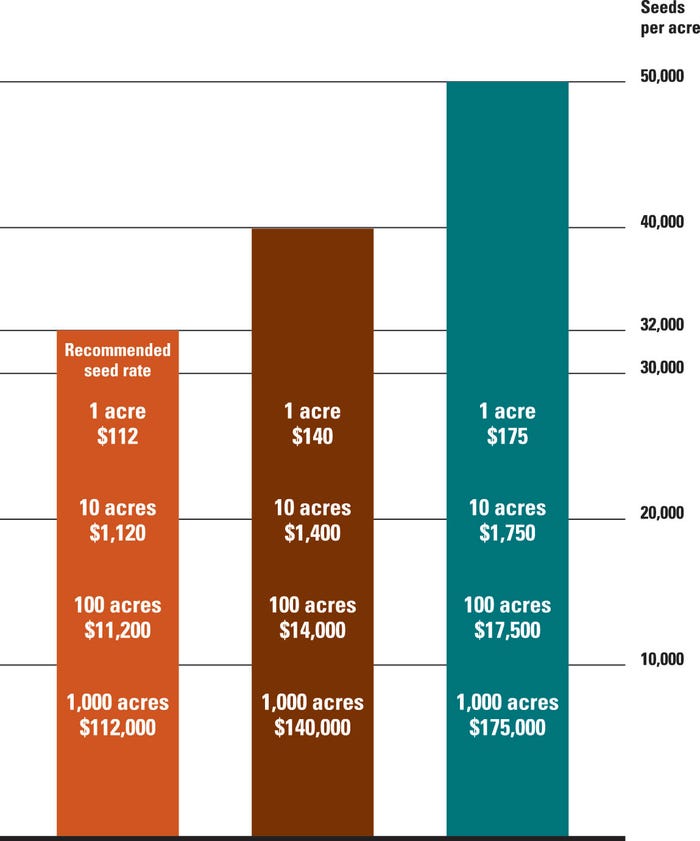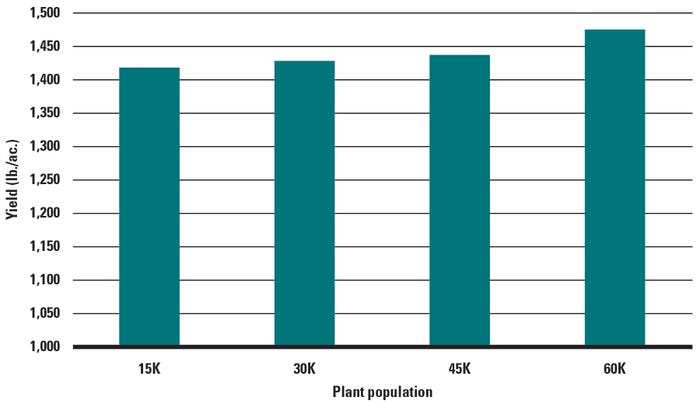
CORN
“We have done a lot of work in recent years to determine the best plant populations for corn, under a variety of conditions and soil and seed types. Most of the time, across most of the Delta Region, 32,000 to 34,000 plants per acre is a good target for corn on irrigated acres, and around 28,000 plants for dryland.”— Jason Kelley, University of Arkansas Extension Agronomist
Considerations include soil health/fertility factors, soil moisture/temperature, irrigated versus dryland, date of planting, yield potential (soil texture — sandy soils versus heavy clay), and varietal differences.
Kelley advises growers that optimum seeding rates across a single or multiple fields can vary because of contributing factors such as soil conditions, which are not always uniform. Also, cool or wet planting conditions could contribute to seeding rate requirements.
Other considerations include single versus twin-row and row spacing. Regardless of single or double-row corn cropping systems, Kelley says, seeding rates should remain about the same in order to reach maximum plant populations and crop yields. Under most conditions, about 95 percent of seeds planted will emerge.
“Corn seeding rates of around 32,000 per acre are generally enough to maximize yields on most hybrid seeds, while limiting risk from late season lodging, and it keeps seed cost at a manageable level,” he says.
More seed in the ground doesn’t provide greater yields. More seed than required to achieve target plant populations and yields increases costs, and can reduce yields by compromising soil nutrients and available water, especially in a dry year. (Table 1: 2017 Average cost of hybrid seed per acre)
Table 1: Average 2017 hybrid corn seed costs per acre in Delta $3.50 per 1,000 seeds

“When more seed is planted than necessary to reach a desired plant population, yield potential is going to flatten out, the chances for lodging increase, and seed costs naturally go up when more seed is planted than is actually required,” Kelley cautions.
Shallow seeding is not better for early emergence, he says. Planting seed at a 1.5-inch depth is not better than planting at a recommended depth of about 2 inches in the Delta. After post-planting rains, seeds can end up near the surface, especially in lighter soils, which can lead to poor root development and lodging.
Another common problem with shallow seeding is losses to blackbird feeding, especially in early-planted fields. Bird repellent may increase costs.
SOYBEANS
“We would like to average a seeding rate for soybeans of about 120,000 seeds per acre, but a lot of growers are still seeding at 140,000 to 160,000. We have also seen 110,000 seeds per acre, even a little less, is ample to grow a good soybean crop."— Todd Spivey, LSU AgCenter Extension Soybean Specialist
Considerations include:
Planting date is critical. — Spivey says the optimum window (from the first of April to first or second week of May) is most desirable for planting most Delta soybeans. A seeding rate of 110,000 seeds per acre is optimum, but if planting early, as in late March, seeding rates should be increased by 10 percent to 15 percent to counter the negative effect of cool weather planting. If planting from mid- to late May or early June, seeding rates should be increased because of the potential for poor vegetative infrastructure needed to set the number of pods required to produce a profitable crop.
Other seeding considerations:
Soil types could dictate the need to increase or decrease seeding rates. — Seeding rates could be decreased on lighter, sandy soils, and increased on heavier soils. Exceptionally wet or dry fields may affect seeding rates. An average across a farm for soybean seeds should hover around 120,000 seeds per acre.
Spivey says it is possible to grow a profitable crop with seeding rates as low as 50,000 seeds per acre, though that’s not recommended except for growers who know their land well and have experienced success at lower seeding rates.
COTTON
Seed Cotton Yield Table:

“In the Delta, I would suggest 40,000 to 45,000 cotton seeds per acre, but research data indicates growers can produce as good a cotton crop with 15,000 plants as they can with 50,000 plants — under optimum growing conditions, and as long as weather or other factors don’t interfere.”— Darrin Dodds, Mississippi State University Extension Cotton Specialist
Growers familiar with their fields can employ variable seeding rates, Dodds says, if they know and understand specific areas within a field that are subject to wet or dry conditions or poor fertility. A larger seeding rate can be used in those areas; a lower seeding rate is possible where cotton plants thrive because of soil and environmental conditions.
In determining how many plants you have on an acre, Dodds recommends taking note of the number of 2-foot to 3-foot skips. With a solid stand of cotton for several feet followed by large gaps, but a plant population average of 15,000 or greater, producers will probably experience yield reductions, he says. If the field has a minimum of 15,000 healthy plants per acre and minimal 2-foot to 3-foot skips, growers should have good yield potential on that acre.
Poor emergence and low plant populations can be problematic, but Dodds says cotton is resilient and can withstand low populations and still make a profitable crop. It is necessary to manage the crop well to maximize yields.
About the Author(s)
You May Also Like






